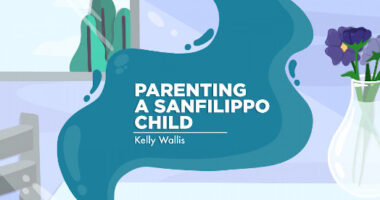Raising an Adult Child With Sanfilippo Syndrome Is Tiring

I am tired. Caring for my 25-year-old daughter, Abby, whose body is giving up on her, is tiring.
She has Sanfilippo syndrome, a cruel, relentless disease that is stealing her from me. When I have time to sit and gain perspective of the situation and face the fact that this disease will end her life at some point, I am incredibly sad. But the day-to-day care she needs is so tiring. I have to be sure someone is caring for her while I write this column.
This may come across as whiny and complaining, but it is where I am right now, and I apologize for this upfront. Most of the time, I try really hard to be positive and thankful. The fact that I am even able to have children is a miracle, and I am grateful for that. I have such a supportive family around me, and that is a huge blessing. Abby is deeply loved by so many people. We know when she leaves this earth, she will be whole, complete, and with Jesus and all who have passed before her. But today, I am tired.
All parents and caregivers who care for special needs or disabled individuals experience this at some point. There are the “why did this happen to my family” days and the “this isn’t fair” days. We humans don’t like to be inconvenienced! That is selfishly part of it for me. My youngest daughter has graduated, moved out, and is working. My husband and I are supposed to be empty nesters at this point, like many of our friends who are our age.
Part of why I feel this way is I have been doing this since Abby was about 2 years old. I did not know it at the time, but Sanfilippo children are very hyper, and she definitely fits this description. Her toddler years were exhausting, but I was younger then! Her adolescent and teenage years were difficult because of her oppositional behavior, but she was much more capable and independent then.
I am 52 now; I am not old, but I am older than I was when I used to chase her around. My husband and I sleep with iPads mounted to the walls beside our bed so we can see her through the camera in her room. She is often restless and stirs or wakes up startled throughout the night, so we never sleep through the night. There are also nights when she hardly sleeps at all, as many Sanfilippo kids experience. Multiple nights like this take their toll.
Taking her anywhere is usually difficult because her motor planning is so poor that getting her in the car is quite a challenge. But she is too big to pick up, so we have to try and move her legs for her or maneuver her body as best we can. And we live in Houston, so it is almost always hot, and Abby no longer sweats due to Sanfilippo, so we are eager to get her into the air-conditioned car as quickly as possible.
Once we arrive wherever we are going, it is not uncommon for her to have diarrhea, another very common symptom of Sanfilippo. So, we again maneuver her into whatever building we are entering and get her to the restroom, which is always awkward because she is unsteady on her feet. Meanwhile, when people see her, they don’t understand the situation, then expect her to have a conversation, and look puzzled when she doesn’t respond. It is understandable, but it can be frustrating for us at the same time.
These experiences, when added together, make for a tired mom! Then, when I lie down at night and reflect on the day, I feel guilty for losing my patience or even having the feelings I have described. It is a roller coaster, as I have described in a previous column. I am not sure what the answer is, but it helps to release my true feelings into the atmosphere.
I will end by saying that although my situation is difficult, there are families with far worse circumstances. It is a necessary disclaimer. Yes, I am tired and frustrated, but it could be worse. I hope this column at least presents feelings that other families and caregivers can relate to and that it helps portray an honest picture of daily life with a Sanfilippo child.
***
Note: Sanfilippo News is strictly a news and information website about the syndrome. It does not provide medical advice, diagnosis, or treatment. This content is not intended to be a substitute for professional medical advice, diagnosis, or treatment. Always seek the advice of your physician or other qualified health provider with any questions you may have regarding a medical condition. Never disregard professional medical advice or delay in seeking it because of something you have read on this website. The opinions expressed in this column are not those of Sanfilippo News or its parent company, Bionews, and are intended to spark discussion about issues pertaining to Sanfilippo syndrome.







danielle bertola
Reading that your daughter is 25 I believe that this is a miracle. We just lost our little cousin Charlotte, she was almost 17. Her parents Frédéric and Stéphanie created a foundation in Switzerland. We are just about to publish a report on all the different research efforts that are made to alleviate the disease. Our site is www.fondation-sanfilippo.ch. Please don't dispear. Much love. Danielle.
Vikram Sehgal
Dear Kelly
Thank you for sharing! I have a 7yrs old boy who’s just been diagnosed with a slowly progressing version of Sanfilippo (MPS III A) and we have understood that our journey shall be long and the future so challenging.
Heartfelt wishes for peace and strength to you & yours.
Vikram
Ta-Neha Smith
Reading your story I had to hold back emotions because your story is similar to mine. I just found out and I’m going thru a whirlwind of emotions. It put this mps in perspective and i thank you for your honest truth!